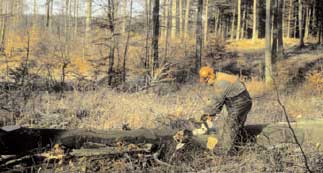|
| Front page | | Contents | | Previous | | Next |
Adapting to the Climate of the Future
Example 3 The decline of Norway spruce
Owners of forests still remember the storm in 1999, which did so much damage to their forests and to their economy. Most damage was done to spruce plantations. A large proportion
of Danish forests consists of mono-cultures – mostly Norway spruce, which is neither particularly capable of withstanding storms, nor of facing the overall effects of climate change.
More storm incidents, and storms of greater intensity, may, however, be one of the negative consequences of a changed climate in Denmark – and amongst the negative impacts on the
forests, massive windfall is the most severe.
The rotation time of forests is 50-150 years, if we disregard Christmas trees. Many of the trees we plant today must therefore also be able to grow in the climate of the 22nd century.
Therefore, we have to start adapting to the effects of climate change in Denmark already now.
Danish studies show that the climate change envisaged will generally enhance tree growth, mainly of species having their northern boundary of distribution in southern Scandinavia.
Reduced volumes of precipitation in the summer may, however, reduce this benefit, and more drought-tolerant species may be preferable. Even if we cannot be sure how the climate will
develop over the next century, we still have to base our decisions on the future climate scenarios that are available.
Figure 2
The distribution of Norway spruce
Norway spruce needs cold winters, and its natural distribution generally follows
the January temperature limit of minus 2 °C. If the temperature rises for
instance 4 °C, the boundaries might move to the present minus 6 °C limit.
It should be noted that Denmark is already now outside the present natural area
of growth.

(According to: J. Bo Larsen).

The Danish forest programme
The Danish forest programme takes the first steps in this direction by planning major changes to the forests, the most important one being a shift from
current forestry practices to close-to-nature silvi- culture. The forest programme sets out guidelines for sustainable forestry, which forest owners can use on a voluntary basis as a
practical tool for sustainable forestry practices – including also a sound economic basis. One of the guidelines focuses on the introduction of forests consisting of a mixture of native
species, which are more robust on our latitudes. The aim is to increase the stability of the forests by allowing the forests to develop more on nature's own premises than does traditional
forestry.
This strategy is also very well suited to take into account future climate change.
Mixed species forests include a larger number of tree species in different age groups, thus spreading the risk of windfall and drought. Another benefit is reduced vulnerability to diseases
and pests that might otherwise cause problems in a changed climate, and increase the consumption of pesticides. Mixed species forests also enhance the diversity of animal and plant life.

Plenty of reasons to integrate concerns for future climate change into forestry developments
- Tree production will be required also in the future.
- The forests have many visitors and are used for a range of recreational activities.
- The forests serve a valuable purpose by contributing to safeguarding the groundwater resources and by offering habitats for the many different animals and plants living in our forests
also in the future.
- The forests act as carbon sinks, thus mitigating the climate change.
The implementation of the forest programme provides a number of options for promotion of close-to-nature forestry management.
The Norway spruce is on the decline
Norway spruce has been planted in Danish forests since the end of the 18th century, and now accounts for approx. 27 per cent of the Danish forest area, which makes it the most
common tree in forests in Denmark. It is also the only tree species in Denmark that we are fairly certain will show a declining trend in a warmer climate.
An important element in a more robust forest development will be to stop planting Norway spruce in mono-culture and less suited soil conditions. The share of Norway spruce must be
reduced in Danish forestry, but, pending more certain climate projections, Norway spruce can still be used to mix with other species in wellsuited localities.
Since the storm in 1999, the Danish forestry sector has started thinking and acting along the lines presented in the strategy.
Already now the Norway spruce is showing signs of weakening – most recently in 1989-1991, possibly because winter temperatures were above those most suitable for Norway
spruce.
Forest fires
In a warmer climate with less rain in the summer, forest fires may become more frequent, but this is not expected to cause a major problem in Denmark. Still, it would be wise to review
the fire contingency closely, to see if we are properly prepared, should fire accidents happen.
| Front page | | Contents | | Previous | | Next | | Top |
Version 1.0 December 2004, © Danish Environmental Protection Agency
|